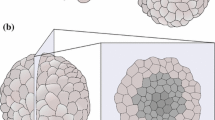Abstract
Multicell spheroids, small spherical clusters of cancer cells, have become an importantin vitro model for studying tumour development given the diffusion limited geometry associated with many solid tumour growths. Spheroids expand until they reach a dormant state where they exhibit a grossly static three-layered structure. However, at a cellular level, the spheroid is demonstrably dynamic with constituent cells migrating from the outer well-nourished region of the spheroid toward the necrotic central core. The mechanism that drives the migrating cells in the spheroid is not well understood. In this paper we demonstrate that recent experiments on internationalization can be adequately described by implicating pressure gradients caused by differential cell proliferation and cell death as the primary mechanism. Although chemotaxis plays a role in cell movement, we argue that it acts against the passive movement caused by pressure differences.
Similar content being viewed by others
Literature
Acker, H., J. Carlsson, R. Durand and R. M. Sutherland (Eds). 1984.Spheroids in Cancer Research. Berlin: Springer-Verlag.
Adam, J. A. and S. A. Maggelakis. 1990. Diffusion regulated growth characteristics of a spherical prevascular carcinoma.Bull. math. Biol. 52, 549–582.
Algire, G. M. and H. W. Chalkley. 1945. Vascular reactions of normal and malignant tissuein vivo.J. Nat. Cancer. 6, 73–85.
Alt, W. and D. A. Lauffenburger. 1985. Transient behavior of a chemotaxis system modelling certain types of tissue inflammation.J. math. Biol. 24, 691–722.
Balding, D. and D. L. S. McElwain. 1985. A mathematical model of tumour-induced capillary growth.J. theor. Biol. 114, 53–73.
Deakin, A. S. 1975. Model for the growth of a solidin vitro tumor.Growth 39, 159–165.
Dew, P. M. and J. Walsh. 1981. A set of library routines for solving parabolic equations in one space variable.A.C.M. Trans. Math. Software 7, 295–314.
Dorie, M. J., R. F. Kallman, D. F. Rapacchietta, D. van Antwerp and Y. R. Huang. 1982. Migration and internalization of cells and polystyrene microspheres in tumour cell spheroids.Exp. Cell Res. 141, 201–209.
Dorie, M. J., R. F. Kallman and M. A. Coyne. 1986. Effect of Cytochalasin B, Nocodazole and irradiation on migration and internalization of cells and microspheres in tumour cell spheroids.Exp. Cell Res. 166, 370–378.
Folkman, J. 1984. Tumour angiogenesis.Adv. Cancer Res. 43, 175–203.
Goldacre, R. J. and B. Sylven. 1962. On the access of blood-borne dyes to various tumour regions.Br. J. Cancer. 16, 306–322.
Greenspan, H. P. 1972. Models for the growth of a solid tumor by diffusion.Stud. Appl. Math. 52, 317–340.
Greenspan, H. P. 1976. On the growth and stability of cell cultures and solid tumours.J. theor. Biol. 56, 229–242.
Hirst, D. G. and J. Denekamp. 1979. Tumour cell proliferation in relation to the vasculature.Cell Tissue Kinet. 12, 31–42.
Jones, B. and R. S. Camplejohn. 1983. Strathmokinetic measurement of tumour cell proliferation in relation to vascular proximity.Cell Tissue Kinet. 16, 351–355.
Keller, E. F. and L. A. Segel. 1971. Model for chemotaxis.J. theor. Biol. 30, 225–234.
Lauffenburger, D. A. and C. R. Kennedy. 1983. Localized bacterial infection in a distributed model for tissue inflammation.J. math. Biol. 16, 141–163.
Maggelakis, S. A. and J. A. Adam. 1990. Mathematical model of prevascular growth of a spherical carcinoma.Mathl. Comput. Modelling. 13, 23–38.
McElwain, D. L. S. and P. J. Ponzo. 1977. A model for the growth of a solid tumour with nonuniform oxygen consumption.Math. Biosci. 35, 267–279.
McElwain, D. L. S. and L. E. Morris. 1978. Apoptosis as a volume loss mechanism in mathematical models of solid tumour growth.Math. Biosci. 39, 147–157.
McElwain, D. L. S., R. Calcott and L. E. Morris. 1979. A model of vascular compression in solid tumours.J. theor. Biol. 78, 405–415.
Moore, J. V., H. A. Hopkins and W. B. Looney. 1984. Tumour-cord parameters in two rat hepatomas that differ in their radiobiological oxygenation status.Radiat. Envir. Biophys. 23, 213–222.
Moore, J. V., P. S. Haselton and C. M. Buckley. 1985. Tumour cords in 52 human bronchial and cervical squamous cell carcinomas: Inferences for their cellular kinetics and radiobiology.Br. J. Cancer. 51, 407–413.
Murray, J. D. 1989.Mathematical Biology. Berlin: Springer-Verlag.
Myerscough, M. R., P. K. Maini, J. D. Murray and K. H. Winters. 1990. Two dimensional pattern formation in a chemotactic system. InDynamics of Complex Interconnected Biological Systems, T. L. Vincent, A. I. Mees and L. S. Jennings (Eds), pp. 65–83. Boston: Birkhauser.
Sincovec, R. F. and N. K. Madsen. 1975. Software for non-linear partial differential equations.A.C.M. Trans. math. Software. 1, 233–260.
Strauli, P. and L. Weiss. 1977. Cell locomotion and tumour penetration.Eur. J. Cancer. 15, 1–12.
Suh, O. and L. Weiss. 1984. The development of a technique for the morphometric analysis of invasion in cancer.J. theor. Biol. 107, 547–561.
Sutherland, R. M. 1988. Cell and environment interactions in tumor microregions: the multicell spheroid model.Science 240, 177–184.
Tannock, I. F. 1968. The relation between cell proliferation and the vascular system in a transplanted mouse mammary tumour.Br. J. Cancer 22, 258–273.
Thomlinson, R. H. and L. H. Gray. 1955. The histological structure of some human lung cancers and the possible implications for radiotherapy.Br. J. Cancer. 9, 539–549.
Wette, R., I. N. Katz and E. Y. Rodin. 1974. Stochastic processes for solid tumour kinetics II. Diffusion-regulated growth.Math. Biosci. 21, 311–338.
Young, J. S., C. E. Lumsden and A. L. Stalker. 1950. The significance of the “tissue pressure” of normal testicular and neoplastic (Brown-Pearce carcinoma) tissue in the rabbit.J. path. Bact. 62, 313–333.
Author information
Authors and Affiliations
Rights and permissions
About this article
Cite this article
McElwain, D.L.S., Pettet, G.J. Cell migration in multicell spheroids: Swimming against the tide. Bltn Mathcal Biology 55, 655–674 (1993). https://doi.org/10.1007/BF02460655
Received:
Revised:
Issue Date:
DOI: https://doi.org/10.1007/BF02460655




